We here at Goonhammer Historicals like a good airplane. With co-editor Mugginns getting all up into the air war in Bag the Hun, and Masters of the Air gracing your TV screens right now, it’s a good time to drop some knowledge bombs (or torpedoes). Today we’re going to take a look at some of our favorite interesting, weird, dominant, and awful airplanes of World War 2. Remember what Sailor Malan (South African born Top Ace who commanded an RAF squadron during the Battle of Britain) said:
- Wait until you see the whites of his eyes. Fire short bursts of 1 to 2 seconds and only when your sights are definitely ‘ON’.
- Whilst shooting think of nothing else, brace the whole of the body, have both hands on the stick, concentrate on your ring sight.
- Always keep a sharp lookout. “Keep your finger out!”
- Height gives You the initiative.
- Always turn and face the attack.
- Make your decisions promptly. It is better to act quickly even though your tactics are not the best.
- Never fly straight and level for more than 30 seconds in the combat area.
- When diving to attack always leave a proportion of your formation above to act as top guard.
- INITIATIVE, AGGRESSION, AIR DISCIPLINE, and TEAM WORK are the words that MEAN something in Air Fighting.
- Go in quickly – Punch hard – Get out!

Marc “llor” Renouf
Plane: Vought F4U Corsair
Manufacturer: Chance Vought
Manufacture Location: East Hartford, Connecticut (Vought), Arizona (Goodyear), New York, New Jersey, Pennsylvania (Brewster)
Number built: 12,571
Dates of service: 1942-1969
Primary users: US Navy, US Marines
Wingspan: 41 ft 0 in
Engine horsepower: 2,380 hp
Max Speed: 446 mph
Crew: 1
Range: 1005 mi
Armament: 6x 0.50 M2 Browning machine guns (three in each wing), with 375-400 rounds of ammunition for each gun
Primary purpose: (fighter, transport, bomber, fighter bomber, etc) Fighter. Later models were used in the ground attack role
Interesting Variants: The F4U-1D was the original version delivered to the US Navy
The F4U-4 variant put in a dual supercharged engine that was capable of 2,450 hp, and while compromises were made with the fuel configuration reduced range, the climb rate rose from an already respectable 2,900 ft/min to an unreal 4,500 ft/min. That’s like being strapped to a rocket. The F4U-4 also switched from the older 3-bladed propeller to the more iconic 4-blade variant.
Operational history: The F4U saw action throughout the Pacific theater of operations in WW2, where it racked up an impressive 11:1 kill ratio against Japanese aircraft across all types. Japanese pilots regarded it as one of the most dangerous of American aircraft. By the invasion of Okinawa in April of 1945, it was also being used in the ground attack role, with variants sporting 20mm cannon and rockets.
Corsairs were the planes flown by the famous “Black Sheep Squadron” (popularized by the popular mid-1970s TV show “Baa Baa Black Sheep.” The leader of that unit, Major Gregory “Pappy” Boyington) racked up an impressive 22 air combat kills while flying F4U aircraft.
Even after the US and European nations had retired the Corsair from service, it saw action in the air forces of developing countries much later. The last air combat kills in a Corsair happened during the “Football War” between Honduras and El Salvador in 1969. That kind of operational service is impressive for any aircraft, especially a prop-driven plane designed at the dawn of the jet age.
Why you like it: Because it’s freaking gorgeous! Just look at it! Also because as a kid I watched the old “Baa Baa Black Sheep” on TV as it was being aired (yes, I am an old). But more than that, everything about the plane just screams “power!” The fact that the designers bent the wings to lower the landing gear such that the plane could accommodate a larger propeller is hard-core. It’s one of those cases where “more” really is the correct design decision, and the final package was an aircraft that was frighteningly effective at the task for which it was designed.
Oh, and did I mention that those graceful gull-wings actually fold up such that the plane can be stored using less deck space on a carrier? If you get the chance, go to the Udvar-Hazy annex of the US Air and Space Museum near Dulles Airport. There’s a Corsair hanging right in front of the mezzanine balcony just as you enter, so you can get right up close to it. It’s an absolutely beautiful machine.
Modeling opportunities: Because it is such an iconic airframe manufactured in such large numbers, pretty much everyone who makes miniatures for WW2 aircraft is going to make a Corsair.
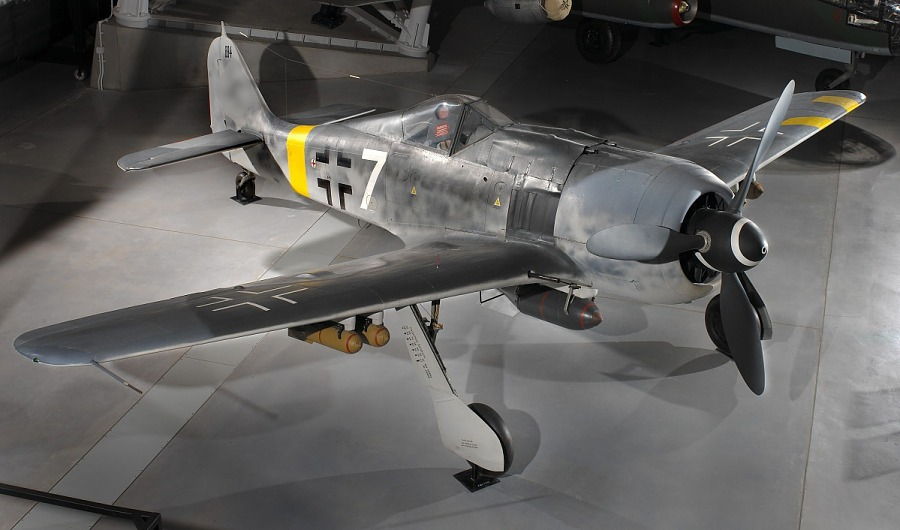
$ean
Plane: Focke-Wulfe 190 Wurger “Shrike”
Manufacturer: Focke-Wulf
Manufacture Location: Germany
Number built: 20,000+
Dates of service: 1941-1945
Primary users: Germany and Hungary
Wingspan: 10.5 m (34 ft 5 in)
Engine horsepower: D-9 Variant 1,730hp
Max Speed: 686 km/h (426 mph) at 6,600 m (21,700 ft)
Crew: 1
Range: 835 km (519 mi)
Armament: 2 × 13 mm (0.512 in) MG 131 mgs and 2 × 20 mm (0.787 in) MG 151 cannon
Primary purpose: Fighter, but widely adapted as a night fighter, fighter bomber and reconnaissance fighter.
Interesting Variants: There were many different variants and field upgrade kits which means defining many planes as one “type” is often impossible. The A series was the most common fighter variant. The D series was a high altitude fighter with a different V12 engine. Ground attack variants were designated F and, fighter bomber variants designated G.
Operational history: One of the two workhorses of the Luftwaffe’s Fighter Arm the FW 190 is not as Hollywood famous as the “Messerschmitt” ME 109. The FW 190 was a superior aircraft at low and medium altitudes but its performance fell off above 20,000 feet. The FW 190 proved a rude awakening to Spitfire pilots when it was first encountered in 1942. As part of the Raid on Dieppe the RAF amassed a large fighter force of over 50 squadrons to cover the landing. The plan was to force the Luftwaffe to fight on allied terms and deliver a serious defeat. As the landing progressed Luftwaffe fighters were concentrated against it from across France and the Low Countries. The RAF failed to deliver their knockout blow losing 88 fighters to 20 FW 190’s lost.
The rugged airframe and greater lift capacity than the Me-109 meant the FW-190 was the basis for many modifications and upgrades. The Sturmbocke were equipped with increased armour, 30mm cannons and rockets to take on allied heavy bomber formations. Night fighter versions were equipped with radar. The strong undercarriage allowed it to see heavy use as a ground attack aircraft, primarily on the eastern front. Where it was equipped with bombs, rockets and external 30mm cannons. The late war Ta 152 high altitude variant was only produced in limited numbers but was one of fastest aircraft of the war capable of flying at 755 km/h (469 mph). In the last days of the war the FW 190s provided airfield cover for ME-262’s on their long landing approaches. The plane was popular with many German aces and Hans Ulrich Rudel the “Stuka Pilot” would end the war flying a ground attack FW 190.
Why you like it: The FW 190 balanced the air war for a time, outperforming the existing models of Spitfire. As the war progressed the highly adaptable airframe was modified to fill almost any role imaginable.
Modeling opportunities: (who makes minis for it?) The FW 190 is available in many different scales as a model kit. It is also available in Warlord Games “Blood Red Skies”.
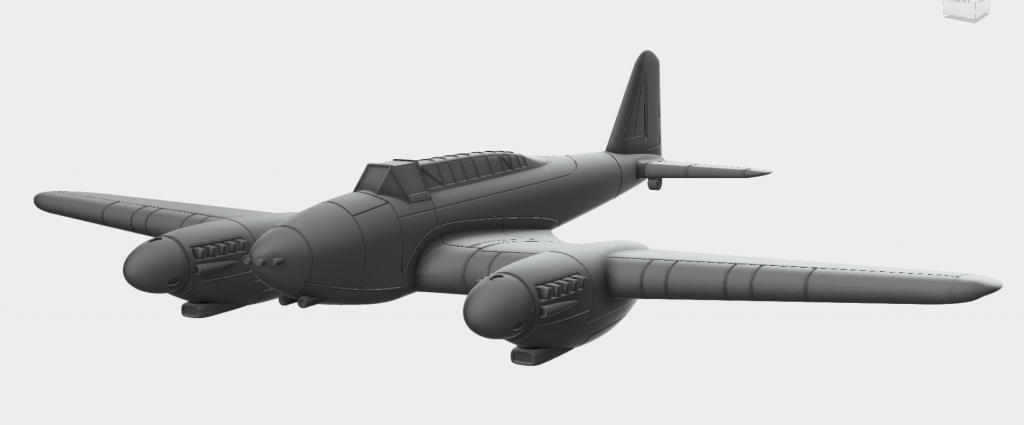
VarianceHammer Eric
Plane: Short Selkie
Manufacturer: Short & Harland
Manufacture Location: Belfast
Number built: 417
Dates of service: 1941 – 1957
Primary users: Irish Air Corps, Royal Canadian Air Force
Wingspan: 16.46m (54ft)
Engine horsepower: Twin Rolls-Royce Merlin II engines (1,030 HP each)
Max Speed: 570 km/h (354 mph)
Crew: 2
Range: Approximately 1,000 miles
Armament: 4x .303 Browning Machine Guns, 2x 20mm Hispano cannons, 1x Rear-firing .303 Vickers K machine gun
Primary purpose: Heavy Fighter/Night Fighter. Later variants also served as both land and maritime fighter-bomber.
Interesting Variants: Mk3 “Super Selkie”, which was equipped with substantially more powerful Merlin 21 engines, which sacrificed two of the .303 machine guns for two additional 20mm cannons, as well as allowing the addition of drop tanks, and wing racks for up to eight rockets of 250 lb bombs.
Operational history: When the United Irish Republic entered the war in mid-1940, the need for an Irish-built fighter aircraft to supplement the constrained supplies of Hawker Hurricanes that could be purchased from Britain was recognized. Ireland’s distance from Germany meant any such fighter was unlikely to encounter the agile BF-109, and would instead primarily fight German bombers and potentially their BF-110 escorts. Irish Air Corps commissioned the nation’s single established aircraft manufacturer, Belfast’s Short & Harland, to produce a twin-engine heavy fighter suited for that role.
Armed with the hindsight of the early days of the war, and cribbing heavily off the largely parallel Bristol Beaufighter and de Havilland Mosquito development, Short developed an adaptation of the ill-fated Fairey Battle. The Selkie addressed many of the Battle’s shortcomings – adding an additional engine to provide a much needed increase in speed, considerably increasing the plane’s armament at the expense of bombing capability, and adding self-sealing fuel tanks. This choice of overall airframe design addressed one of the primary concerns of the Air Corps – that with an extremely inexperienced cadre of pilots, the Selkie had to be relatively straightforward to fly, a property for which the Battle was already well regarded.
Relatively fast and well armed, the Selkie proved to be a capable, workman-like fighter. It’s first major engagement involved three relatively green squadrons during the Irish Blitz, when over 200 German bombers attacked Dublin, Belfast and Cork, with Irish Hurricanes and Selkie’s downing 26 of the aircraft as well as causing many of the bombers to miss their targets.
The Selkie would see further use in nearly all the theaters the Irish were involved in, most extensively in maritime patrol and anti-shipping duties in the North Atlantic, Irish Sea, and Bay of Biscay, intercepting German bombers as well as conducting anti-submarine patrols and attaching Axis shipping.
Four squadrons were transferred to the Italian front, serving in both fighter and light attack roles, and several more squadrons, based in Britain, would provide support for the joint Irish-Canadian landing at Juno Beach during the invasion of Normandy.
Why you like it: What’s not to like about getting together with a friend to spitball the design of a fictional heavy fighter for a fictional country that never actually entered the war? And then being able to bring that to life thanks to a 3d printer.
Modeling opportunities: Custom commissioned model by Eric Beers (https://cults3d.com/en/users/edible/3d-models)
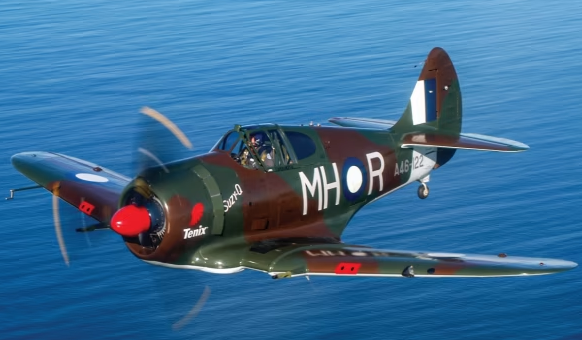
BoatyDweeb
Plane: CAC Boomerang
Manufacturer: Commonwealth Aircraft Corporation (Australia)
Manufacture Location: Port Melbourne, Australia
Number built: 250
Dates of service: 1943 – 1946
Primary users: Royal Australian Air Force
Wingspan: 10.97m (36 ft)
Engine horsepower: 1,200hp
Max Speed: 491km/h (305mph)
Crew: 1 pilot
Range: 1,500km (930 miles)
Armament: 2x 20mm autocannons and 4 .303in Browning machine guns
Primary purpose: Originally a fighter, later ground attack and observation
Operational history: Listen, up until here you’ve been reading about aircraft that were built on easy mode. We’re done with that now. It’s time to get Australian.
The colonies weren’t at the top of the pecking order during World War Two… or in fact, any war ever, except possibly for the Emu War (in which they were very definitely the first in line to be pecked). Resources were scare and quality parts even moreso, leading to the growth of an indigenous war industry built around just sort of getting on with it with whatever you could get your hands on. This is the kind of desperation that solved the problem of tank engine shortages by nailing three V8s together and calling it a Sentinel.
So in that context, the Boomerang could never have been a Spitfire. While it was somewhat well-received by the RAAF, the fact remained that it was slow, climbed poorly, and has a documented history of never killing any other aircraft. It was gradually adapted for other roles, including forward observation and ground attack, at which it was much more successful.
Why you like it: Okay look, the underdog story is fun, but I’ve buried the lede. The first pilot to scramble from Australian soil against the Japanese was Flight Lieutenant Roy Goon, who survived the war and went on to survive the war and eventually pass away the day before Something Awful was launched.
Goon is emblematic of Australian pilots throughout history, enduring incredible hardship on long patrols over water in aircraft that were the best the country could provide in severely adverse conditions. He was deservedly awarded for his service, and his contribution to the war is acknowledge on a 50-metre long Bayeaux Tapestry-esque scroll called the Harvest of Endurance which is held at the National Museum of Australia.
Modeling opportunities: Apparently everyone, including Airfix. You will have no trouble at all finding one of these.
Michael O “Mugginns”
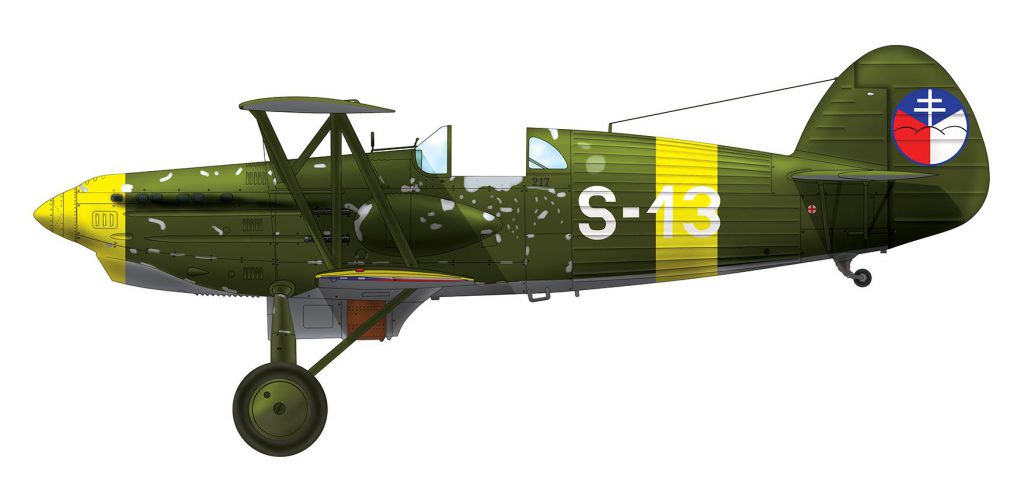
Plane: Avia B 534
Manufacturer: Avia
Manufacture Location: Prague
Number built: 568
Dates of service: 1933-1944
Primary users: Czechoslovakia, Slovakia, Bulgaria
Wingspan: 30ft 10in
Engine horsepower: 849 hp
Max Speed: 252 mph
Crew: 1
Range: 600km
Armament: 4 7.92mm VZ 30 machine guns, 6 22lb bombs
Primary purpose: Fighter
Interesting Variants: BK-534 included a 20mm Oerlikon cannon.
Operational history: The Avia B-534 was a Czechoslovak biplane designed and produced during the interwar period. Czechoslovakia was well-known for producing quality equipment that was used by many countries during WW2, mostly minor powers. Bulgaria had quite a few and actually turned them on Germany in the fall of 1944 when they saw the writing on the wall. Most of my interest comes from the use by Slovakia during the war – they had around 90 Avias and used them first against Poland, then USSR, then eventually Germany.
At one point during a raid against Soviet land targets, one Slovak airman was shot down and had to be picked up – his wingman picked him up and the airman flew home on the aircraft’s struts. Slovak pilots flew over 1,000 missions in Soviet territory. In September 1944 Slovakia decided to abandon Germany during the Slovak National Uprising. It didn’t go well for Slovakia – they were punished very harshly by SS units and brought to heel quickly – but one Slovak pilot did the get the last confirmed kill with a biplane when he took down a Hungarian JU52 on its way to Poland.
Why you like it: It looks cool, it’s a biplane that was used in WW2, and it was used by Slovakia. The stories of pilots riding the wings home and the last biplane kill ever are nuts.

Plane: TBF Avenger
Manufacturer: Grumman & General Motors
Manufacture Location: Eastern seaboard
Number built: 9,839
Dates of service: 1941 – July 1960
Primary users: US Navy, British Navy, Canadian Navy, New Zealand Air Force
Wingspan: 54 ft 2 inches
Engine horsepower: 1,700 hp
Max Speed: 278 mph
Crew: 3
Range: 905 miles
Armament: 1 M1919 Browning machine gun on nose, or two on wing. One M2 Browning dorsally mounted and another M1919 ventrally mounted. Could carry 2,000 lbs of bombs or one 2,000 lb torpedo. Later variants included rocket mountings
Primary purpose: Torpedo bomber
Operational history: TBFs (or TBM, if manufactured by General Motors) were the most widely-used torpedo bombers of WW2, credited with taking down the Yamato and Musashi – two huge super-battleships that Japan had put into service. The frame of the aircraft remained in service into the 1960s, showing how versatile it was.
Many of the bombers at Midway were of the Douglas TBD Devastator model – largely obsolete by the time the USA entered the war. The USN needed a new bomber, so the Avenger was prototyped and built. The plane is huge, with a ton of space for radios, taking up most of the space behind the pilot where two other crew could sit. Avengers could carry one Mark 13 Torpedo, a 2,000 pound bomb, or four 500 pound bombs. Pilots claimed it ‘flew like a truck’ – perhaps a good description for a bomber with long range, big radios, and a cockpit that worked well for flight commanders.
Six Avengers were on Midway Island at the Battle of Midway. They really didn’t have a great showing – five were shot down and the other came back extremely damaged. Once the USN pilots figured out how to fly better, worked on their coordination, and the US produced better torpedoes, the Avenger became a vital bomber in America’s arsenal.
Why you like it: It’s massive and has a humungous canopy, including a turret at the back. My grandfather was a radio operator on Johnson Atoll in the Pacific and while he didn’t see any combat that I know of, he told me he did train as a ‘tail gunner’ – I like to imagine that during his time in the Navy maybe he flew as a radioman and ventral gunner in the Avenger. He’d always mention how much mutton they were forced to eat, and how they had to jump into New York Harbor in their ‘dungarees’ – the experience of a lifetime.
Musterkrux

Why you like it: In a world slowly pivoting towards metal airframes, de Havilland was the mad lad who committed to his bit of making high performance wooden aircraft. After a series of ‘prolonged misunderstandings’ with the British Air Ministry the Mosquito, an aircraft concept that was conceived of in 1938 (before the war had formally kicked off), finally went operational in late 1941. From then on, the Mosquito swept from success to success until the end of the war in Europe.
The Mosquito was a twin-engine fighter, bomber, fighter-bomber, photo reconnaissance aircraft built primarily from wood. Designed to be fast, the Mosquito’s plan to deal with enemy interceptors was to simply outrun them. This concept arose during a time when the British Air Ministry had decided that the bomber paradigm was one of heavy armour and significant defensive armaments. So, one could say that the meta was that everyone assumed that fighters would inevitably catch bombers, therefore bombers needed to focus on surviving combat rather than avoiding it.
Enter de Havilland, who saw this status quo and said: Absolutely the fuck not. At first the Air Ministry was opposed to the notion, because if you could ever accuse a British institution of one thing it was being dogmatic to the point of insanity. However, as the war continued and it became apparent that the desperate need for metal across the full war industry stressed British manufacture and import capabilities the Mosquito’s proposed wooden construction started to become more appealing to the sort of island nation that was both kept on life support via the merchant marine but was also surrounded by U-boats…
If you’ve ever played Settlers of Cataan you’d understand how de Havilland was desperately trying to explain to the War Ministry that if they traded him even just a little of their substantial Wood he could give them Mosquitos but they kept insisting that they’d just hard roll 10’s for Metal to build Spitfires. They finally got there, though.
It became clear that de Havilland was firmly correct in his assertion that one does not need guns or armour if one can simply outrun the opposition.
In a particularly notable operation, in 1943, while trying to celebrate 10 years of Nazi government, Mosquitos from the 105th and 139th decided to pull a Kanye and while Hermann Göring was giving a speech, bombed the main Berlin broadcasting station:
“Yo Hermann, I’m really happy for you. Imma let you finish but Churchill had one of the best speeches of all time..”
Then, just to prove it wasn’t a fluke they went and did it again later that day during a speech by Joseph Goebbels.
Now, you know you’ve got Göring’s attention when he orders the formation of not one but two special Jagdgeschwader dedicated to hunting you down. They failed, of course.
I hope I’ve successfully sold you on why the Mosquito is one of the GOAT Fighters. Like any wargamer that wants to make the podium, de Havilland read the meta and got ahead of the curve, going with a ‘RAF Wood Things’ build that the Germans simply couldn’t counter.
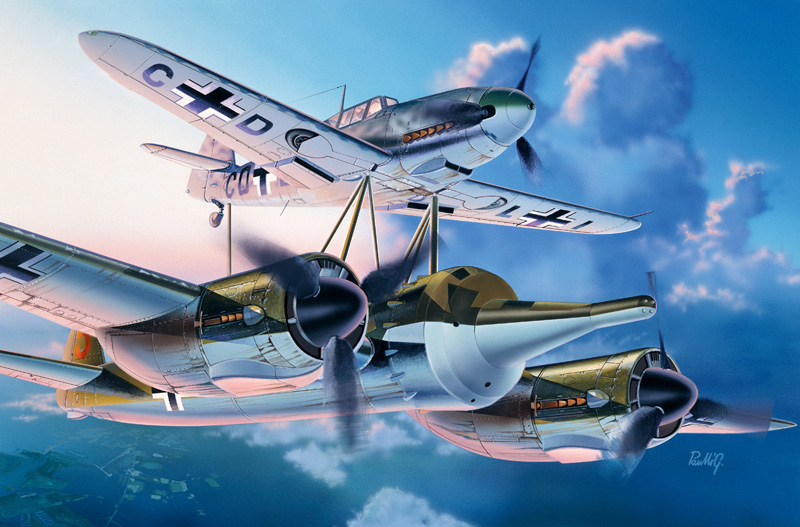
Plane: Mistel
Why you like it: A Junkers and a Focke-Wulf fly into a decommissioned dreadnought sounds like the start of a joke.
No joke though, my friends. Someone in the German aerospace research team decided that if they were going to lose the war they were at least going to spend their remaining R&D budget on doing insanely cool shit like duct-taping smaller planes onto larger ones. Also, the larger airframes would have their cockpits replaced by 2-tonne shaped charges. Because reasons. To be fair, this is pretty much how my gameplay evolves in round 4+ of a tournament when it becomes apparent that my win-rate is no longer going to be positive.
When you start to fail to meet your original objectives, just move your goal posts to ‘making insane things happen for laughs’.
Generally, a Mistel (German for Mistletoe, don’t ask) was composed of a Junker-88 bomber with a fighter (either a Bf-109 or FW-190) strapped to the top of it. The plan was that both aircraft would be controlled from the fighter, with the bomber-half being lined up on a target before the fighter blew some explosive bolts* to separate the two aircraft, so the pilot could return to base.
As such, you might say that the Japanese might have invented the Kamikaze attack but trust the Germans to work out a way to bring the pilot home…
Operationally, the Mistel underperformed badly because, to no-one’s surprise, the aerodynamic performance of two aircraft stapled together is not terribly impressive. During its first deployment at the Battle for Normandy, a Mosquito pilot (see my earlier comments about that Wooden Monarch of a Plane) would shoot down a Mistel and described it as a ‘cinch’.
Now to be fair that pilot was Walter Dinsdale, which meant that he had the advantage of both being Canadian and the sort of chad who went into politics as an advocate for human rights, First Nations peoples, as well as people with disabilities. So, I can only assume that he just made everything he did look easy.
So, while the Mistel could possibly be described as a raging failure at an operational level I think it’s super important that we respect the chutzpah it takes to fly two aeroplanes into enemy territory just so you can yeet one of them at your opponent’s favourite toys and still have a plane to fly home.
*Just because I love the German language, it’s worth noting that the term for these was Kugelverschraubung mit Sprengbolzen (literally: ball screw connection with explosive bolt). Say that three times fast.
Have any questions or feedback? What’s your favorite warplane of WW2? Leave a comment below or drop us an email at contact@goonhammer.com


